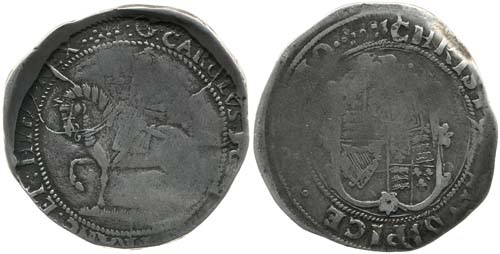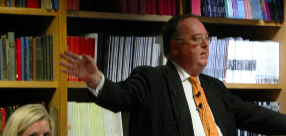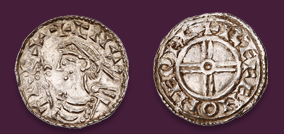
Auction: 5033 - The Colin Adams Collection of Halfcrowns
Lot: 210
Charles I, Truro mint (1642-43), Halfcrown, 13.48g., small equestrian portrait of king in armour, holding sword upright walking left, sash flies back in two loose ends, grassy ground below, CAROLVS D G MAG B[.] FRANC ET HIB REX, rev. oval garnished shield similar to Tower type 2a, lis dividing C R above, CHRISTO AVSPICE REX, group of nine pellets after REX and REGNO, m.m. buglehorn (JGB 1021 (this coin); Besly A1; N.2541; S.3046) off-centre and poorly struck from a cracked obverse die (as all the five known specimens), otherwise fine, a piece of great rarity and historical importance Estimate £ 2,500-3,000PROVENANCE: V J E Ryan, Glendining, 22 January 1952, lot 1182 J G Brooker, SCBI 33, no.1021 Baldwin´s Auctions no 21, 11 October 1999, lot 1081 On 14 November 1642 a commission under the Great Seal of England, dated from Hampton Court, was sent to Sir Richard Vyvyan of Trelowarren empowering him to erect one or more mints in the county of Cornwall to produce, from whatever bullion could be obtained, coinage of the prevailing weights and measures to be delivered to the local commander, Sir Ralph Hopton. It has long been known that Vyvyan chose to site his mint at Truro, and Besly has identified a letter from a Walter Kestell inferring that Vyvyan had commenced coining by 26 December 1642, BNJ 1992 p.103. The ´bugle´ Halfcrown has long been recognised as having distinct Truro affinities, the only real discrepancy being the mintmark, very clear on this piece, which on all accepted Truro coins is a rose. Besly, pp.113-4, points out that the ´bugle´ Halfcrown corresponds closely, harp and mintmark excepted, to the dies that belong at the head of the Truro series, even down to the forked serifs of the C´s. The lettering is hand cut and, on the obverse, small and tentative and this die also bears the fullest form of the King´s titles. He confidently places it as the very first of Sir Richard Vyvyan´s Halfcrowns, struck at Truro from dies, which quickly cracked and broke. Besly also notes that there is a striking similarity between the Latin words cornu, or buglehorn, and Cornubia, Cornwall, which is as likely an explanation as any of this mintmark.
Sold for
£5,000




